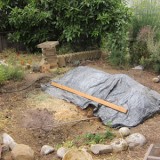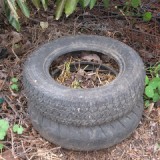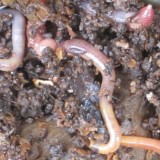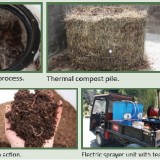
Image: Wikimedia.
Call it a weird, unintended consequence of our ongoing drug war, but apparently indoor compost piles are igniting house fires all across the U.S. Pot growers stack up their leftover biomass and, soon after, the whole house goes up in a puff of smoke, so to speak.
It got me wondering about two things. What’s the biology of a compost pile fire? And do non-pot growing folks in cold climates commonly have indoor compost piles?
First the biology. BioCycle has a whole article on fire prevention in municipal composting facilities that covers this common problem.
So what situation(s) can lead to a fire? Here’s what can happen with a low moisture, large pile with little air exchange, combined with water getting into the pile in a place where there is enough air to support biological activity and chemical oxidation, but not enough to cool the pile.
An old, dry compost pile, or a pile of overs screened out of the finished product, is a case in point. Water seeping into the dry compost can restart microbial activity and initiate reheating. A “macropore” or crack from the hot spot to the surface often develops into a vent, or chimney. Air movement up through this vent draws more oxygen into the hot spot where heat is being generated, rapidly escalating the transition from a biological fire to smoke and glowing embers. Appearance of this hot, humid air at the surface can be an important indicator that heating is taking place inside the pile.
Compost pile fires are unlikely for most home scale gardeners. One preventative technique recommended in the Biocycle article is to keep piles smaller than 12 feet high. Not a problem for most backyard gardeners.
Now a question for our readers around the world: who, other than pot growers, have indoor compost piles?






It used to be a very common cause of fires in dairy barns. If hay has too high a water content it can heat and catch fire in a barn. I think that farmers used to add salt to try and control the microbial activity and lessen the chance. I don’t know if it happens much anymore because I think that they mostly used giant round bails and store them outside now. Not quite the same thing as a fire in a compost pile, but exactly the same principle.
We have had a couple of large industrial size compost fires in Phoenix over the years, fills the Valley with smelly smoke sometimes for days at a time- http://www.abc15.com/news/region-phoenix-metro/central-phoenix/compost-fire-sends-smoke-into-phoenix-sky
I can’t imagine it happening, but a lot of people have indoor worm bins here, but they’re usually monitored pretty closely for temp and moisture to keep the critters happy, but you never know, I suppose worm castings could catch fire just as easily as compost could………….
Will Bayx, of Sonoma Compost, told a story about consulting with another city that had a compost pile fire every day. And they were proud of it! He had to tell them that it’s not a good thing.
I think a worm bin fire is highly unlikely too.
Yea, probably not a lot of 12 foot tall worm bins out there either. (=
the first thought I had was hay fires, too. There was one at a nearby town in WI this spring. We see a lot of what looks like shrink-wrapped bales (to keep moisture out) in the fields around here!
science: http://ext.wsu.edu/hay-combustion.html
“do non-pot growing folks in cold climates commonly have indoor compost piles?”
Presumably this crowd knows about Jean Pain? If not seems relevant…
https://www.youtube.com/watch?v=JHRvwNJRNag
I was going to mention Jean Pain–thanks for the reminder.
I’m from the north and have never heard the like! Indoor compost pile? Phew! But we did have to pull all the hay out of our barn while the local fire department stood by with hoses pointed at the barn door. We have a thermometer on a long probe that we stick into the center of the hay pile. There is a temp. range from “fine” to “call the fire department”. You could probably use the same numbers for an enormous compost pile.